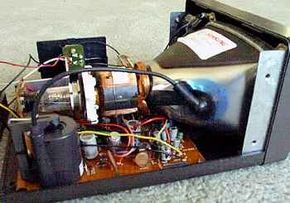The first thing to understand is that any TV or computer monitor that is based on a cathode ray tube (CRT) contains a lot of glass (see How TVs Work for a description of CRTs). If you have ever tried picking up a 21-inch (53-cm) monitor or a 25-inch (or larger) TV, you know that all the glass in a large CRT can easily weigh more than 50 pounds (23 kg).
It turns out that the glass in a CRT contains a lot of lead. A big CRT can contain up to 5 pounds (2.2 kilograms) of lead. It is mixed into the glass for two reasons:
Advertisement
- It improves the optical quality of the glass. Adding a small amount of lead to glass is very common when creating glass for lenses, and you may have also heard of leaded crystal. Optical quality is especially important at the front of the CRT.
- It acts as a shield against radiation generated by the electron gun and electron beam.
The problem with lead is that very small amounts of it cause lead poisoning, so there is a large effort to keep lead out oflandfills and incinerators. Communities in the United States have programs to recycle CRTs and television sets.
Here are some interesting links:
Advertisement
